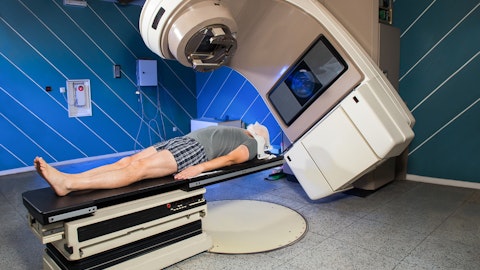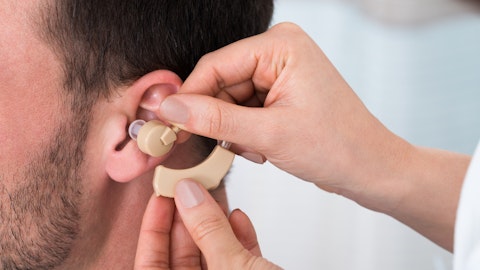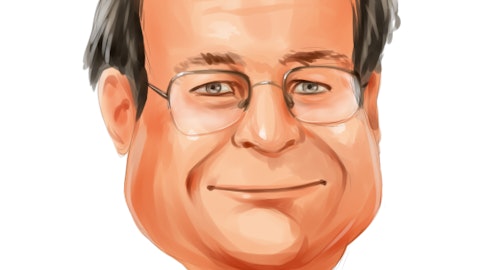Frank Takkinen: Okay, that’s helpful. Then maybe shifting over to some general commentary around the on-boarding process and utilization expectations. My assumption is some of these systems go in and then there’s probably a process of weeks, months or maybe quarters until your treating urologist is comfortable with the system. Maybe walk through the on-boarding process, how long that typically takes and what kind of utilization metrics we can get to at different goal posts, maybe three months, six months, 12 months.
Ryan Rhodes: Yes, the on-boarding process, I’d say first of all, we get better and better at this process, and I think part of that is we understand better how to launch the programs, and we sell programs. We also see hospitals starting to book patients sooner for treatment, even in advance of them actually purchasing or finalizing the purchase of the system, so that helps us ramp quicker. We’ve got a training team and an apps team that helps in the on-boarding, and of course our direct clinical sales team, they take an active role in that process. I think how we do it, how we deliver it has become more efficient. We’ll continue to work on that, we do track metrics around this. I think it’s hard to give you a number of procedures in a period of time, but clearly the first few months tend to ramp at a different pace than the latter months, because as they’re looking for patients and patients can come into that favorable intermediate risk category, they may be starting their program with patients that have failed radiotherapy, so they may be looking at a different type of patient.
But all in all, I think we’ve gotten better at the process, there are on-boarding metrics that we share internally. We don’t share procedure numbers today outside the company, but I think we’re excited with the momentum and getting better at the on-boarding process and in shortening the cycle time from the period when they get the technology into their facility and they start doing cases. Again, I think as we get better as a company, those on-boarding processes improve over and over. That’s what we can share with you. We’re excited about how we do it today, but we’re always looking for improvements to make that process better and better.
Frank Takkinen: Okay, makes sense. I’ll stop there. Thanks for taking the questions.
Ryan Rhodes: Thank you Frank.
Operator: Thank you. Ladies and gentlemen, as a reminder, if you’d like to join the question queue, please press star, one on your telephone keypad. Our next question comes from the line of Ramakanth Swayampakula with HC Wainwright. Please proceed with your question.
Swayampakula Ramakanth: Thank you. Good morning folks. Ryan, I know you don’t give the number of procedures, but just want to get qualitative commentary from you in terms of how you see the flow in terms of procedures once you have the new reimbursement in place starting from January 1, over the last three months; and also in terms of placements, do you see the number of leads increasing post-January 1 with the new reimbursement in place?
Ryan Rhodes: Yes, so I think we shared on the call, RK, that one of the things that we looked at, obviously, is reimbursement continued on in January. We maintained an APC level 6 status within CMS. There was a little increase too, a couple hundred dollars at the facility level – that’s always good, I think, for the hospitals. Again, this is all about providing patient access. When we work with those hospitals, which is common, we look at the pro forma analysis, look at reimbursement which may be very specific to their area. As you know, there’s a calculation, as I referenced in my comments, that there’s an average number but it may be higher, it’s based on facility point of care because that takes into consideration the [indiscernible] labor index for that facility – that’s an average number I shared.
The reimbursement has been very favorable. That really helps when hospitals are looking to make the investment, they obviously want to look at the economics because we are a new service line, and we fare well in that process. I think again, maintaining our APC level 6 effective January 1 helps us to continue on the pathway we’re on, hospitals make continued investments, they look at the technology, they look at the opportunity to move first in the market as it relates to focal therapy, and many hospitals want to take advantage and do first mover in their markets, not unlike other technologies or other service lines when they’re early in their adoption. In terms of procedure impact, again I think it certainly helps on the procedure side, but I think more importantly as we place more and more systems, we create a higher level of patient awareness which should lead to more or increased patient demand, and if we can continue on that pathway, our plan obviously is to do more procedures per system, so each facility performing more procedures as we ramp these programs, and that’s over time creating more demand in the market for other hospitals to make the necessary investment in starting a Focal One program.
Swayampakula Ramakanth: Thank you for that. You talked about how the Swiss reimbursement has helped get a sale in Switzerland, and you were expecting similar things to happen in France. Are there any other geographies that could also help increase placement throughout 2024? Then a question on endometriosis, I understand the data is going to be coming out in 2024 in the second half. In terms of filing, what else needs to be done, and potentially when could you file on this?




